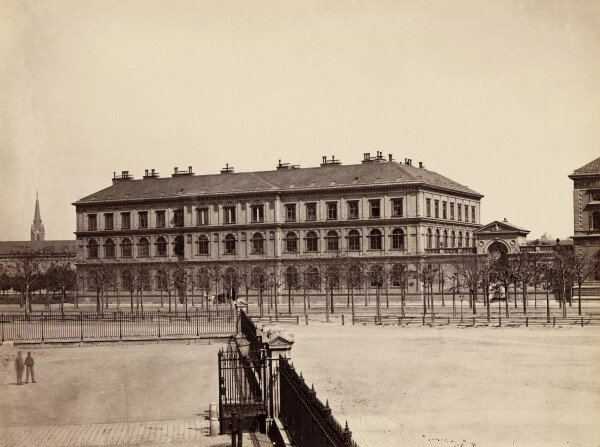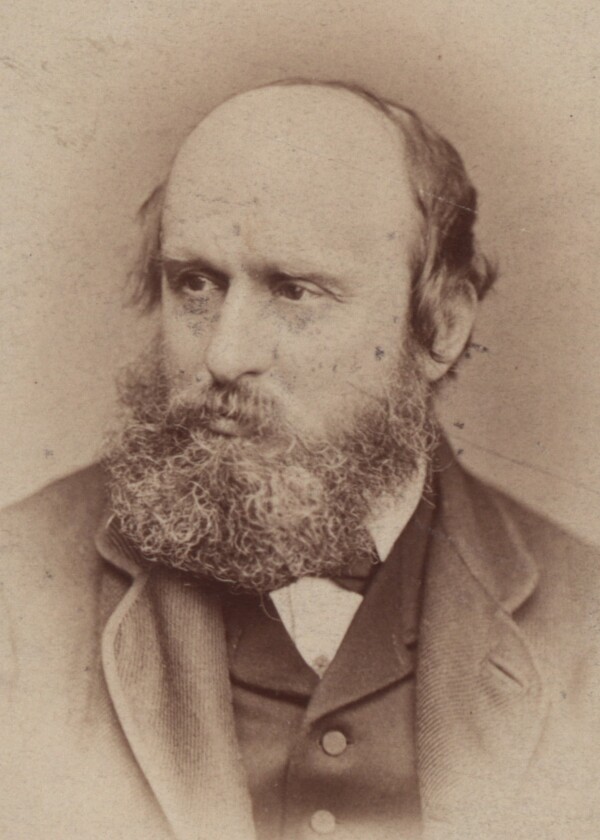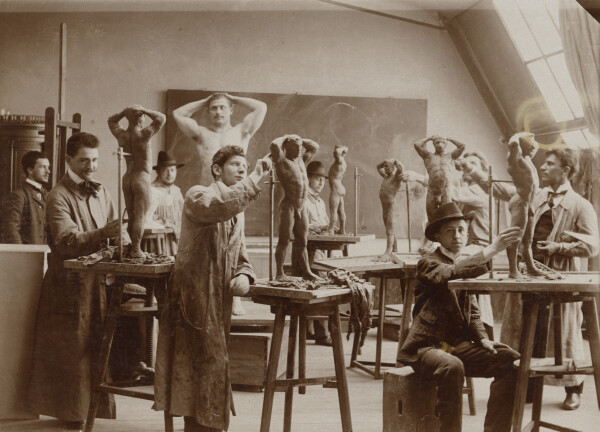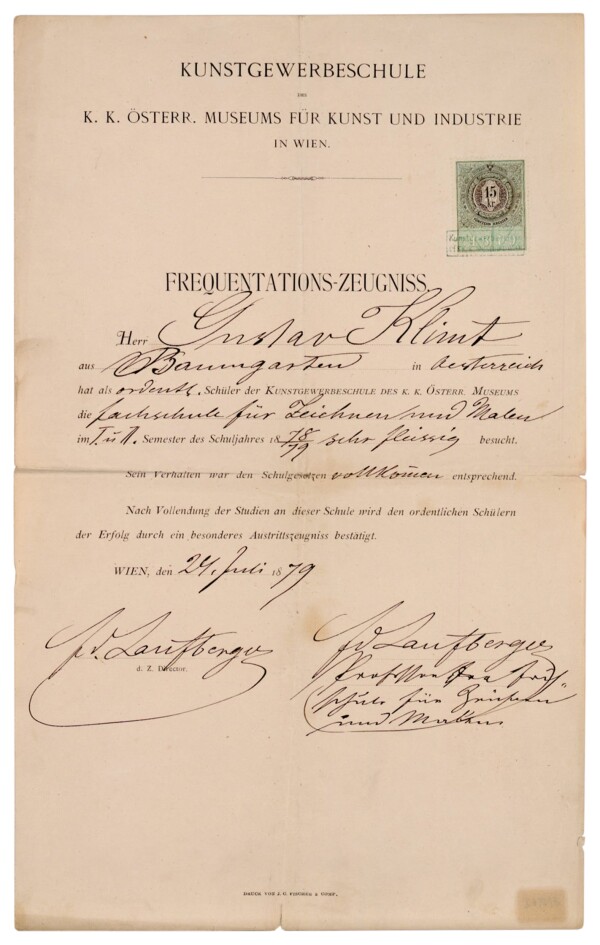Imperial-Royal School of Arts and Crafts

Imperial and Royal School of Arts and Crafts, around 1880
© Wien Museum

Rudolf Eitelberger photographed by Ludwig Angerer, around 1880-1885
© Wien Museum

View of Anton Kenner's class, Department for Teacher Candidates, Imperial and Royal School of Applied Arts, 1900-1903, Art Collection and Archive, University of Applied Arts Vienna
© University of Applied Arts Vienna, Collection & Archive
The Imperial-Royal School of Arts and Crafts (now University of Applied Arts Vienna) was founded in 1867 as part of the Imperial-Royal Austrian Museum of Art and Industry (now MAK). Its aim was to educate young artists, primarily through the study of the objects in the museum’s collections. From 1875 to 1883, Gustav Klimt received his artistic training at the school.
The Imperial-Royal School of Arts and Crafts was founded on the initiative of Rudolf Eitelberger, the first professor of art history at the University of Vienna, in 1867. The school was incorporated into the Imperial-Royal Austrian Museum of Art and Industry, which had been founded in 1863 and was modeled on the South Kensington Museum in London (now Victoria & Albert Museum). Its aim was to reform arts and crafts in light of the ongoing process of industrialization and to document traditional artisan techniques of Historicism for teaching purposes. Eitelberger himself was appointed director of the museum, which was housed in a new building constructed by Heinrich Ferstel at Stubenring 5 from 1871. The architect Josef von Störck, one of the builders of the Court Opera, became the first director of the School of Arts and Crafts.
Like its English counterpart, the museum was to provide the objects in its collections as a source of creative inspiration to artists, artisans and industrialists. In combination with the museum, the School of Arts and Crafts served as a modern facility providing education and training to young artists.
The training facility, initially called Supreme School of Arts and Crafts, was at first situated at Brenner Palace, a former gun factory on the corner of Währinger Straße 11–13 and Schwarzspanierstraße 17.
From 1872, the school was housed on the top floor of the recently completed Museum of Art and Industry. Five years later it moved into its own new building at Stubenring 3 – adjacent to the museum – which had also been built by Heinrich Ferstel.
The aim of the Imperial-Royal School of Arts and Crafts at the Imperial-Royal Austrian Museum of Art and Industry was to educate young artists and artisans. The School of Arts and Crafts admitted female students from the beginning, a practice that was still unusual at the time. Their training opportunities were limited to specific subjects, however.
The main pillar of the education provided by the school was the study of the objects in its historic collections. The school was structured into preparatory classes and so-called specialist classes, divided into the three areas architecture, sculpture as well as painting and drawing. 1900 marked the administrative separation of the school and the museum.
Felician von Myrbach, a founding member of the Vienna Secession, was appointed director of the school at the turn of the century. As a consequence, more Secessionist artists were invited to join the faculty, including Kolo Moser, Josef Hoffmann, Adolf Böhm and Alfred Roller. The School of Arts and Crafts became the cradle of Austrian Jugendstil. Teaching methods shifted from the copying of historic templates towards free design and the observation of nature. Thus, the School of Arts and Crafts became the most important training facility for modern art. Alfred Roller, another artist of Viennese Modernism, acted as its director from 1909 to 1934.
The most famous graduates of the Imperial-Royal School of Arts and Crafts include Gustav Klimt as well as Oskar Kokoschka, Kolo Moser, Ernst and Georg Klimt, Franz Matsch and Josef Hoffmann.

Frequentation certificate from the Imperial and Royal School of Arts and Crafts in Vienna for Gustav Klimt, completed and signed by Ferdinand Laufberger, 07/24/1879, The Albertina Museum
© The ALBERTINA Museum, Vienna
Gustav Klimt at the Imperial-Royal School of Arts and Crafts
Gustav Klimt was admitted to the School of Arts and Crafts in 1875. Several report cards prove that he initially attended the preparatory class, aspiring to become a drawing teacher. Together with Franz Matsch and Ernst Klimt he received a thorough academic education, primarily based on the copying of plaster casts of ancient sculptures.
Klimt’s teachers, particularly Michael Rieser, who was head of the preparatory classes at the time, Rudolf Eitelberger, then director of the Museum of Art and Industry, as well as Ferdinand Laufberger, who was in charge of the Drawing and Painting Class, soon recognized the potential of the three young painters. Instead of being admitted to the final exam for teachers after three years of training, the Klimt brothers and Matsch received a scholarship, enabling them to attend Laufberger’s specialist class to train as academic painters. Their teachers repeatedly asked the students, who had formed a studio collective, to help with large-scale commissions. Furthermore, the three young painters were granted use of a studio on the school’s premises at Stubenring 3 where they could work on their commissions, including those they received independently.
The close collaboration between the museum and the School of Arts and Crafts also provided the Klimt brothers and Franz Matsch with an opportunity to exhibit their commissioned works publicly. Eitelberger repeatedly suggested presenting the commissioned works completed by the “Künstler-Compagnie” at the museum. The main curtain that the young artists had created for the city theater in Reichenberg (now Liberec) was for instance exhibited to Viennese audiences at the Imperial-Royal Austrian Museum of Art and Industry for a short period in 1883.
Literature and sources
- Sandra Tretter, Hans-Peter Wipplinger (Hg.): Gustav Klimt. Jahrhundertkünstler, Ausst.-Kat., Leopold Museum (Vienna), 22.06.2018–04.11.2018, Vienna 2018.
- Herbert Giese: Franz von Matsch – Leben und Werk. 1861–1942. Dissertation, Vienna 1976.
- N. N.: Die Kunstgewerbeschule des k.k. österreichischen Museums für Kunst und Industrie, Vienna 1868.
- Die Angewandte. Geschichte der Angewandten Von der k. k. Kunstgewerbeschule zur heutigen Angewandten. www.dieangewandte.at/universitaet/profil/geschichte (01/12/2022).
- Wien Geschichte Wiki. Kunstgewerbeschule. www.geschichtewiki.wien.gv.at/Kunstgewerbeschule (01/12/2022).
- Wien Geschichte Wiki. Universität für angewandte Kunst. www.geschichtewiki.wien.gv.at/Universit%C3%A4t_f%C3%BCr_angewandte_Kunst (03/30/2020).
- Brief von Franz Matsch in Wien an den Magistrat der Stadt Reichenberg, mitunterschrieben von Gustav und Ernst Klimt (vor dem 14.08.1883). VI. – Gd, 202, Signatur 709/4, Karton 188_6, .

